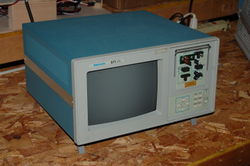571: Difference between revisions
No edit summary |
No edit summary |
||
| Line 29: | Line 29: | ||
This is to protect the user from both high voltage and high-velocity flying debris in the event of a catastrophic component failure during a test run. | This is to protect the user from both high voltage and high-velocity flying debris in the event of a catastrophic component failure during a test run. | ||
The shield is made of a thick high-impact plastic, and the 571 has an internal microswitch so its firmware knows if the shield is in the up or down position. | The shield is made of a thick high-impact plastic, and the 571 has an internal microswitch so its firmware knows if the shield is in the up or down position. | ||
==Internals== | |||
The Tektronix 571 is a computer-based instrument. | |||
Software running in an Intel 8048 microcontroller performs the I-V curve measurements | |||
by sending commands to programmable base and collector power supplies, | |||
and reading the digitized that results. | |||
Software provides the user interface, reading the buttons and generating the displayed bitmap. | |||
The 571 uses an National Semiconductor NS405 Display/Terminal Management Processor IC for generating the | |||
video waveform that is displayed. | |||
The video waveform is fed to a monochrome raster CRT monitor. | |||
===Collector Supply== | |||
The collector supply is a floating programmable power supply. | |||
The output voltage, output polarity, and series resistance are all | |||
controlled by bits sent by the 8048 processor. | |||
The collector supply is linear, using a Darlington configuration of three NPN transistors. | |||
==Specifications== | ==Specifications== | ||
Revision as of 10:00, 24 June 2023
The Tektronix 571 is a curve tracer. It can show the characteristic curves of PNP and NPN bipolar transistors, both N- and P-channel FETs, diodes (including Zener types), and SCRs. It is a microprocessor-controlled device, and user interaction is done through navigation keys. A typical sweep run takes about five seconds. It has a parallel printer output that can print graphics on Epson-protocol dot-matrix printers.
One nice feature of the 571 is its ability to store a set of reference curves, which are displayed as a background for subsequent measurement runs. This makes comparison and matching between devices easy.
The 571 has a well-designed field of parallel-connected sockets to accommodate many different semiconductor package types. Details can be seen in the photographs below.
Because the nature of electronic component testing involves exposing components to sometimes hazardous voltages and operating conditions, at certain settings the 571 will refuse to start a measurement cycle until the user lowers the built-in hinged plastic shield over the socket area. This is to protect the user from both high voltage and high-velocity flying debris in the event of a catastrophic component failure during a test run. The shield is made of a thick high-impact plastic, and the 571 has an internal microswitch so its firmware knows if the shield is in the up or down position.
Internals
The Tektronix 571 is a computer-based instrument. Software running in an Intel 8048 microcontroller performs the I-V curve measurements by sending commands to programmable base and collector power supplies, and reading the digitized that results. Software provides the user interface, reading the buttons and generating the displayed bitmap. The 571 uses an National Semiconductor NS405 Display/Terminal Management Processor IC for generating the video waveform that is displayed. The video waveform is fed to a monochrome raster CRT monitor.
=Collector Supply
The collector supply is a floating programmable power supply. The output voltage, output polarity, and series resistance are all controlled by bits sent by the 8048 processor. The collector supply is linear, using a Darlington configuration of three NPN transistors.
Specifications
Key Specifications
| Collector Sweep | 0.5 V to 50 V (both polarities) with 2 A drive, 0.5 V to 100 V with 1 A drive |
|---|---|
| Vertical Display | plots collector current from 5 μA per division to 200 mA per division with 2% accuracy |
| Horizontal Display | plots collector voltage with 2% accuracy |
| CRT | raster scan, 640x336 resolution, monochrome, magnetic deflection, CRT made by Philips |
| Line voltage | 100 to 240 VAC, 50 or 60 Hz |
| Power | 240 W max − Actual consumption based on transistor being tested |
| Size | (W/L/H) 14.6" × 13.8" × 8.1" |
| Weight | 9 kg (19.8 lb) |
Pictures
-
571, front 3/4 view
-
571, rear view
-
571, measurement head, shield up
-
571, measurement head, shield down
-
571, parameters screen
-
571, run of a 2N2222A transistor
-
571, run of a 1N3020B 10V Zener diode
-
571, inside view
-
571, inside view, closeup of socket board
-
571, inside view, closeup of relays
-











